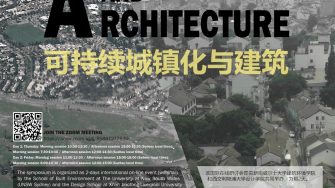
On 13-14 October 2022 UNSW Sydney - School of Built Environment and Xian Jiaotong Liverpool University (XJTLU) - School of Design in Suzhou, China, successfully held the joint 2022 International Symposium on Sustainable Urbanism and Architecture: Australia and China Perspective of Urban Regeneration and Rural Revitalization. The symposium was convened by Dr. Raffaele Pernice (UNSW) and Dr. Bing Chen (XJTLU) as a hybrid event online and in person at Rupert Myers Theatre in UNSW Kensington Campus. Welcome speeches were delivered by the Dean of the UNSW Faculty of Arts, Design and Architecture (ADA), Dr. Claire Annesley and CEO of the National foundation for Australia China Relations (NFACR), Mr. Peter Cai.
The webinar was conducted via Zoom, with event program and abstracts available at the symposium website
This symposium project gathered more than 20 experienced and young scholars, practitioners and academics from Australia, China and Europe who presented and discussed their research on the up-to-date status of art of urban development and rural revitalization and regeneration practices in Australia and China.
In the early half of the 21st century, Australia and China share relevant analogies when it comes to general trends in terms of urbanization and potentiality for future development, despite several obvious social, political, economic and cultural differences as national entities. UNSW Sydney has collaborated with Xi’an Jiaotong-Liverpool University to examine themes related to urbanization, such as urban-rural destruction, economic and spatial regeneration techniques, sustainable land reconversion, eco-urban design approaches and environmental disruption issues. The international symposium, organized as webinar, was conceived as a formal platform where scholars, practitioners and academics from Australia, China and overseas can present and discuss their research on urban regeneration and rural revitalization practices and models in Australia and China, and where they can critically compare and outline the dynamic tension and multiple design, environmental and socio-economic challenges in both countries.
Both countries are set in the Asia Pacific region with vast lands full of natural resources. Recent decades have seen a clear communal pattern in regard to urban growth models and planning strategies, with state-driven efforts prioritizing the expansion of urban centres over rural zones. In terms of regional and urban planning, most urbanization efforts are focused in Australia’s few large metropolises in the state capitals of the East coast – mainly set along the axis connecting Brisbane, Sydney, Canberra and Melbourne; while in China the central government policies have reiterated the strategic importance of the Eastern seaboard, concentrating economic power and growth engines in the sprawling megacities forming an integrated urban network stretching from Beijing/Tianjin, through Nanjing/Shanghai, to Shenzhen/Hong Kong.
A pivotal shift is currently unfolding in both Australia and China. The decades-long process of continuous growth in the primary cities have given way to a progressive modernization of intermediary or second-tier cities, rural towns and regional centres, presented as alternative poles of immigration and new cores of economic growth and prosperity for the nation and the people. Many of the papers outlined or examined the challenges faced by urban case studies in the pursuit of urbanization, whether it be via urban regeneration projects, or new town developments – eg. limited fiscal autonomy, institutional paralysis, lack of communication and coordination in planning and design. On top of pursuing economic success, ad-hoc, state and national development policies focused on qualitative metrics too. Cultural and historical authenticity, ecological restoration, transportation infrastructure among others, were key performance criteria that drove the new movement of urbanization. Urban resilience became the core design driver. Cities, towns and districts alike tackle centurial topics of climate change, outmigration, food scarcity, heritage preservation and standardization of existing housing stock, thereby raising the question as to how these places utilize the current drive of developments to maintain sustainable growth in the next decade.
The selected papers presented at the symposium offered a variety of case studies, innovative investigations, and architectural and urban precedents and theses that will be re-edited and collected in an edited book for publication in 2023.
Sponsors and acknowledgments
- UNSW Sydney, School of Built Environment, Xian Jiaotong Liverpool University, School of Design; The symposium has been funded by an Australian Department of Foreign Affairs and Trade (DFAT) – National Foundation for Australia-China Relations (NFACR) 2021-22 competitive grant (Ref. NFACR21/220476)
- Text by Shen Lim & Raffaele Pernice
- Coordinator of the project: Raffaele Pernice
